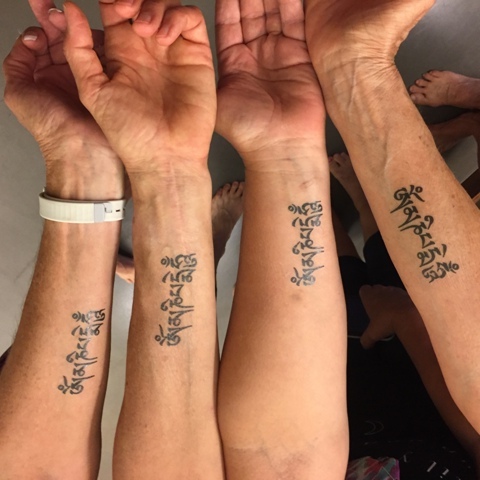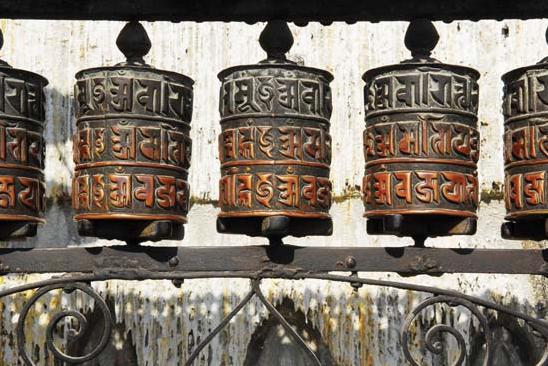Props – devices used to help students align their yoga poses.
Propasana – the practice of putting all props away, neatly folding the blankets and winding up the straps.
While walking down the street in Manhattan one day, my friend bends down to pick up a piece of trash and throws it out in the nearby trash can. This is something I have done before, but I was surprised to see a native New Yorker doing it. When I asked him about it, he said that there was an anti-littering campaign that advertised if every one of New York’s 8.5 million people would pick up just one piece of trash a day, there wouldn’t be any litter on the streets of New York City. He thought it made sense and was doing his part. What would the world be like if we all cleaned up after ourselves?
This is part of the idea of saucha, or cleanliness, the first of the Niyamas, or practices for the self, outlined in the Yoga Sutras. Cleanliness can be interpreted on several levels. There is the cleanliness of the body to promote health. It is recommended that you eat a clean diet, with lots of whole and fresh foods. Eating well promotes health and mental clarity. Junk foods and intoxicants can cloud the mind. Cleanliness can also refer to the thoughts. We are more settled when our thoughts are not disrupted by disturbing emotions such as greed, envy, anger, pride, hatred, lust and delusion. Then there is the cleanliness of our bodies and our physical surroundings.
In How Yoga Works, Miss Friday tells the Captain that yoga works on the outside and the inside. We do poses, breath work and meditation to knock on the pipes from the inside, but we also must knock on the pipes from the outside. She explains it like this: “And there’s this constant interchange going on, you see; this constant interplay of the forces outside and inside of you. You get frantic at work often enough, and it ties up the inner channels. That causes an injury like your back; actually just a reflection of something going on deeper, in the channels. That makes you grumpier, which tightens the choke-points even more, and then because you don’t feel well you’re not as careful about things in general. And one of those things is just simple neatness: tidiness. A lack of this very basic kind of cleanliness – plain old tidiness – is almost a sure sign that your channels are ‘untidy’ too, deep down inside: the thought winds are jumbled up, ready to turn into a new choke-point at any time.”
“And so a very simple and effective way to take advantage of the interchange, the interplay, between outside and inside is just to . . .” I waved my arms around again “. . . clean the place up! If where you live; if where you work; and especially if the place where you do your yoga poses is clean and tidy, then this is all reflected back upon the inner winds, . . .” I paused.
“And the channels loosen up, and the poses work even better on fixing you; on keeping you strong and healthy,” finished the Captain.
“And you see, something else is at work here too. If there’s less junk around the room, then when you go to focus and fix your mind on a single point, then there are not as many things that the mind has to sift through to get at what you want to focus on. It’s a lot easier to find a friend in a group of ten people, especially if they are all lined up , than in a crowd of a hundred all milling around. It takes less effort, much less effort to focus – all day long. Focus is like food for the mind: the mind thrives on it, and so do the good inner winds.”
“And once you are done with your room, “I said, “You can go further. I mean don’t just tidy things up – throw out absolutely as many things as you can. Half the things that fill up our houses at any given moment are things that we don’t even use anymore, at all. And a good part of the other half are things that we rarely use, or don’t really need to use anyway.
“And these extra things in our house, you see, they’re tricky. I mean, it looks like they are just sitting there , pretty harmless, and that’s why we let them stay there.”
“But if I say right now, ‘Think of some of the things in your house’ . . . I paused again so he could do it – and he got sort of an odd look on his face. “Then you can remember a great many things lying around your house, whether you ever use them or not. And that proves, you see, that they were taking up a part of your mind: you can remember them, because information about each one of them is stored in your mind. And the mind – although we don’t often think of it this way – has only so much capacity. Every time you acquire another object – every time there’s one more thing cluttering up your home – then there’s one more thing cluttering up your mind as well. And as the mind goes, so do the inner winds, and the choke points in the channels.”
“What you are saying, then,” observed the Captain, “is that the more unused, use-less things I have lying around, the worse it is for my back, and even my peace of mind, because it hurts my channels.”
“Just so,” I said with a smile. “And when you’re done clearing out the extra things around your house, then you have to go on to your very way of life and do the same. Throw out extra things you do that you really don’t have time to do well, so you can focus. Throw out extra things you say that don’t really need to be said anyway; learn to be with your friends, a few good friends, in a happy sort of silence that you both understand and appreciate. Cut down on all the extra, useless outside stimulation of your physical senses: too much food, too much news, too much ‘entertainment’, too much physical gratification with the opposite sex; all of them fine in themselves, all of them healthy, but in moderation: in amounts that you can focus on and enjoy deeply.”
“And the mind will be free to come inside, and arrive at its own nature: concentration, contemplation, uninterrupted attention – medicine for the channels, medicine for the inner winds, and so for health and a happy state of mind that lasts. It’s all a kind of cleanliness, in a way: tidiness on the outside, tidiness on the inside.”
Take a look at these two pictures:













